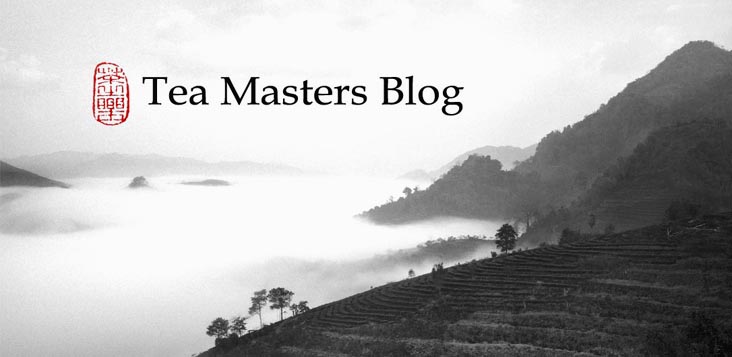
 As summer approaches and temperatures rise, I felt like drinking my Bi Luo Chun. It was picked by hand in San Hsia on February 23, 2009, one of the very first harvests of this spring. And for green tea, earlier means smaller and more tender buds, and lighter fragrances. This is especially true this early spring, with temperatures cold and little rain.
As summer approaches and temperatures rise, I felt like drinking my Bi Luo Chun. It was picked by hand in San Hsia on February 23, 2009, one of the very first harvests of this spring. And for green tea, earlier means smaller and more tender buds, and lighter fragrances. This is especially true this early spring, with temperatures cold and little rain.So, as the heat builds up in my apartment, I don't want to open the A/C just yet. I long for the fresh, flowery breeze of this early spring in the tea hills of San Hsia. If only I could be transported there and then! If only I could escape the walls of concrete surrounding my apartment... (Oops, I've been watching 'Prison Break' last evening!)
The solution (Michael) isn't engineering, but it will require patience and skills: a Ming style Cha Xi featuring this Bi Luo Chun!


Why Ming dynasty? You'll find many reasons in the performance we did last year at the Taipei Story House. Ming scholars also drank loose green tea leaves to feel a connection to nature. This is why my Cha Bu is dark green and I display 2 plants and flowers. My cups are also light green.
The cha wan, tea bowl, used during Sung dynasty to make matcha, wasn't the tea vessel anymore. Maybe they 'recycled' these bowls as za fang, to collect the spent leaves and cleaning water, as I do here...
I started with a small* duanni teapot, but later changed to a glazed gaiwan, a Ming dynasty invention, to give a better account of the tea. (* Big teapots were used during the Ming dynasty.)
 The Bi Luo Chun in San Hsia is made with the Qingxin Ganzhong cultivar. As Chiang Kai-shek fled to Taiwan in 1949 with around 2 million Chineses refuges, they couldn't purchase green tea from the Mainland ennemy. So, the green tea addicts encouraged the production of similar green teas in Taiwan.
The Bi Luo Chun in San Hsia is made with the Qingxin Ganzhong cultivar. As Chiang Kai-shek fled to Taiwan in 1949 with around 2 million Chineses refuges, they couldn't purchase green tea from the Mainland ennemy. So, the green tea addicts encouraged the production of similar green teas in Taiwan. But because Taiwan has Oolong tea skills and culture, the San Hsia Bi Luo Chun is quite different than in China. In some aspects, while still a green tea, the farmers here make it somehow similar to Oolong. For instance, it can brew in just boiled water and its taste will remain quite sweet.
The smell is fresh, small, barely open spring flowers (dandelion, magnolia).
It tastes mellow with a hint of dryness. Cold sunny day.
We made it! I feel cool again!
(Note: the water from the tetsubin brought more depth and mellowness to the tea, but I still felt it was a better fit to use the lighter water from a silver kettle. This also means that a water with lower mineral residue is probably better for this tea.)










6 comments:
Magic.
So thoughtfull...
Michel
I absolutely LOVE the chataku in the very first chaxi picture...
Thanks Michel, thanks for everything!
Kim,
you have very good eyes. I'll introduce those new items probably this week or next!
Hi Stéphane,
I was wondering what you've learned about the effects of a betel nut tree overstory on the tea plants. For example, how is the flavour of the tea impacted, as well as leaf growth and soil conditions. Is this a way to create cooler conditions with shading at lower elevations or just shrewd farmers maximizing productivity?
Cheers,
Mike
Stephane,
Ahh, summer, that dreaded little word. It's 31°C and rising here in Florida. I'll be able to fire clay on my veranda soon enough...
Isn't it interesting how a just few green leaves added to a cup can cool one's body despite the liquor being in excess of 80°C?
I, too, find this chataku simply lovely. Would you mind emailing me your revised price list if you happen to add it to your selection? Also, is that the singing porcelain cup that it is paired with?
Peace,
Tyler (tab28@students.uwf.edu)
Hi Mike,
Yes, the farmer says that the betel trees help cool down the temperature for the Bi Luo Chun. However, I can't really say it has an impact or not, because the plantation is not big enough to separate the harvest of the 'covered' from the 'uncovered' portion.
Tyler,
Yes, I paired the Cha Tuo with the singing cups. (I used 2 different Cha Tuos in this Cha Xi).
Post a Comment